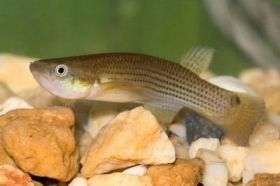Predators do more than kill prey

The direct effect predators have on their prey is to kill them. The evolutionary changes that can result from this direct effect include prey that are younger at maturity and that produce more offspring.
But killing prey also has indirect effects – rarely characterized or measured – such as a decline in the number of surviving prey, resulting, in turn, in more food available to survivors.
In a new study characterizing the complex ecological interactions that shape how organisms evolve, UC Riverside biologists Matthew Walsh and David Reznick present a novel way of quantifying these indirect effects by showing that prey adapt to food availability as well as the presence of predators.
“Our study can serve as a model for how humans alter ecosystems when they remove key predators like wolves and bears from land or tuna and billfish from seas,” said Reznick, a professor of biology.
He and Walsh compared life history traits between Trinidadian fish communities impacted by the presence of predators. They settled on Trinidadian waterfalls as study sites because the waterfalls serve as barriers to the upstream distribution of predator and prey fish, thereby creating distinct ecological communities in similar habitats only a few hundred meters from each other – like test-tubes in nature.
First, they used killifish from “killifish-only” localities, above waterfalls, where killifish are the only fish present; and killifish from “high predation” localities, below these waterfalls, where the killifish coexist with a diversity of predators. Second, they reared the grandchildren of these killifish in a lab at UCR to ensure that any differences observed between populations are likely to be genetic, and not environmental, in origin.
To quantify the direct and indirect effects of predation, Walsh and Reznick reared the killifish under multiple food levels that closely approximated the natural differences in food availability that the killifish experienced in Trinidad.
Their results demonstrate how predators’ direct and indirect effects shaped the way killifish evolved:
-- Killifish from high predation environments are younger at maturity and produce more offspring – the predicted direct evolutionary response to high mortality rates.
-- More food caused all fish to grow faster, then mature at a larger body size and earlier age, plus produce more babies.
-- Killifish from high predation environments gained more from high rations – an indirect evolutionary response to high mortality rates. Their increase in size at maturity, decrease in age at maturity and increase in the number of babies produced were all more pronounced than those seen in killifish from the killifish-only environment – differences that show that the high predation killifish were better adapted to convert high food rations into the production of more babies.
Study results appear in the Jan. 15 issue of the Proceedings of the National Academy of Sciences.
“Research has generally focused on the evolutionary implications of the direct effects of interactions between predator and prey,” said Walsh, a graduate student working in Reznick’s lab in the Department of Biology and the first author of the research paper. “But we found that the indirect effects of these interactions can be as important. Clearly, organisms become adapted to a given food level and evolve to best exploit their resources.”
The researchers argue that in addition to killing prey, the indirect evolutionary and ecological effects of predators cause a restructuring of the community, which in turn contributes to shaping how killifish evolve.
“Removing predators will not only alter the structure of the ecosystem, but will also cause a wider diversity of evolutionary changes in prey than had been considered,” said Reznick, the paper’s only coauthor. “Conversely, it means that the reintroduction of predators, which is an ongoing practice, such as in the reintroduction of wolves in the United States, demands more caution than is currently practiced since the prey will have adapted to a new environment in the time that predators were absent and will be ill prepared in more ways than had been imagined for the reintroduction of predators.
“Likewise, the crash that we have seen in the populations of many commercially exploited species of fish, and their failure to recover when fishing pressure is reduced, has been attributed to such indirect restructuring of the ecosystem.
“Since predator-induced indirect increases in resource availability are common in both terrestrial and aquatic ecosystems, the evolutionary consequences of these interactions are potentially a very important component of evolutionary change in nature,” Reznick added. “Moreover, biologists have observed evolutionary change occurring on short ecological timescales in nature, on the order of a few years to decades, suggesting that such interactions are contributing to overall ecosystem functioning and health.”
Source: University of California - Riverside


















